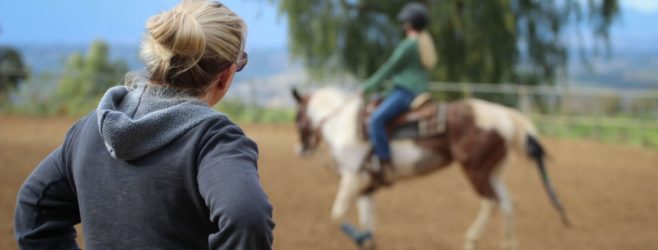Therapeutic Horseback Riding Offers Kids With Cerebral Palsy an Array of Benefits — Not All Physical
“Walk on.”
This is equine language for “let’s go” and words that are offering freedom to kids all across the country who otherwise may feel stuck.
The popularity of therapeutic horseback riding continues to increase across the country, providing kids afflicted with cerebral palsy an opportunity to receive therapy and participate in an engaging sport at the same time.
A non-ambulatory rider experiences the fluid movement of walking because the horse’s gait is similar to humans, according to the Professional Association of Therapeutic Horsemanship International (PATH Intl.).
PATH Intl. serves as the professional association and global authority on equine therapies for those with special needs.
From Wheelchair to Horse
Elizabeth Swantek rides “Callie” each week at Banbury Cross Therapeutic Riding in Oxford, Michigan.
At 22, she’s spent her entire life in a wheelchair or on a couch. So, Saturday mornings mounted on her horse makes her giddy as she sits high atop the brown-speckled animal with the curly mane feeling the smooth movement underneath her.
Her mom witnesses Elizabeth grin ear to ear enjoying feeling like a person without limits for a short time each week as her horse canters around the arena.
Experts say the act of sitting on the animal builds core strength and balance for those with motor difficulties, spasticity issues, weakness, and balance problems, all as a result of cerebral palsy.
Emotional and Social Benefits of Equine Therapy
Yet, it’s not all physical therapy. There’s an emotional and social component as well.
“The unique relationship formed with the horse can lead to increased confidence, patience, and self-esteem,” states PATH, Intl.
Children and adults with cerebral palsy live a life of being different and unable to do much of what others do. Therapeutic horseback riding offers them not only a physical activity they can call their own but a social activity.
While most barns offer private therapy sessions, participants more commonly join a few others in the arena for a session that includes a pre-planned program of exercises, movements, and tasks all done while in the saddle. Parents and caregivers share camaraderie in the viewing room, and the children and young adults feel a sense of belonging with their riding class.
Riders experience a sense of accomplishment and purpose each week as they complete their lesson, all while sitting up high, holding the reigns, building their core muscles, and forcing their body to balance on the large animal.
Most barns run with a paid staff and host of well-trained volunteers who provide hands-on care to keep riders safe.
Depending on the degree of physical disability, a rider may have a “side walker” on either side of him or her for safety. Another volunteer leads the horse. A certified PATH Intl. instructor teaches the class with activities to enforce the goal of building core strength, balance, and fine motor skills.
Therapeutic Horseback Riding First Used 80 Years Ago
According to Banbury Cross Therapeutic Equestrian Center (TEC), therapeutic horseback riding extends back to the 1940s when a small group of therapists in Europe began to use the gentle motion and rhythm of the horse to stimulate the muscles used in the typical human walk.
They discovered the motion relaxed the muscles while stimulating the development and toning of the underlying muscle.
The list for the physical benefits alone is long:
- Rhythm and timing
- Muscle stimulation/strength
- Sensory registration
- Sensory integration
- Movement exploration
- Body awareness
- Fine and gross motor skills
- Postural alignment and control
- Balance and coordination
- Endurance/fitness
- Flexibility/dexterity
For Elizabeth who has been riding fulltime for five years, it not only provides excellent stretching for her spastic leg muscles and a work-out for her core, it gives her something to look forward to every week. It’s something to call her own — something that gives her confidence.
Banbury Cross TEC includes motivation, self-expression, ability to face challenges, decision-making skills, and goal setting as the emotional benefits of the therapy.
PATH Intl. reports almost 900 centers throughout the world that are certified through them and offer therapeutic riding to special needs children and adults. At present, almost 70,000 children and adults participate and receive the benefits of therapeutic horseback riding.
Elizabeth remains unaware of the physical benefits she’s receiving every Saturday morning as her equine friend carries her around the dirt-floored arena.
For her, it’s about belonging, participating, and being a part of an activity that takes her out of a confining chair. It’s about, for once, being above everyone rather than always below, gliding effortlessly on the back of a beast that gives her “legs” for a magical half-hour each week.



